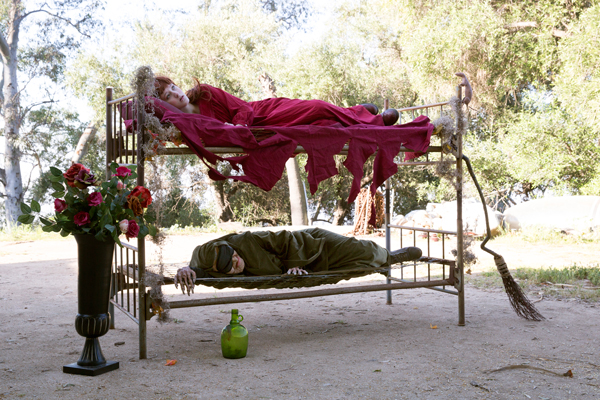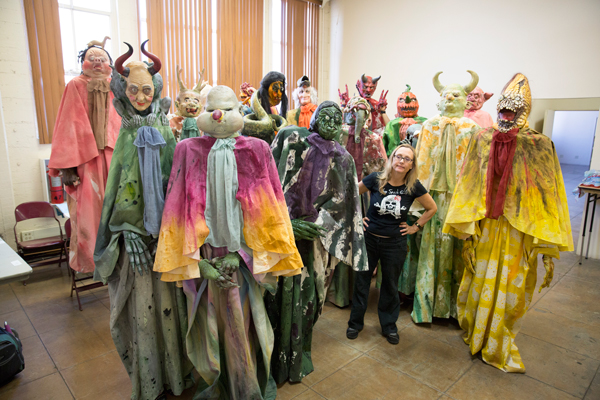The Day of Forevermore, Marnie Weber’s first feature film, is the culmination of the artist’s long career as a weaver of macabre and otherworldly scenarios through art, film and music. Over the last 25 years Weber has created her own distinctive realm of avant-garde folk art, a personalized occultism which, although highly idiosyncratic, is easily accessible on the level of pure entertainment.
The plot concerns a lonely teenage girl, Luna Crimson, who is eager to escape her fiendish and smothering mother—an 800-year-old alcoholic witch named Baba Muthra—and experience the world beyond Forevermore Acres, the sprawling kingdom—part junkyard, part nature sanctuary—that they preside over with an extended family of ghoulish creatures attired in pagan ritual garb and elaborately customized Halloween masks.
This visually intoxicating fairy tale of a horror movie is the result of two years of meticulous planning. The soundtrack alone, composed and performed by the filmmaker, took six months of solid work. Prior to Forevermore Weber’s longest film, A Western Song, was 25 minutes, and none of her previous films have contained dialogue. But when the film’s protagonist, Weber’s remarkably photogenic 15-year-old daughter, Colette—who has already appeared in a number of her mother’s films—insisted on dialogue, Weber obliged by filling the dead time of waiting for jury duty selection by writing a script, much of it in a loose Old English style.
Ultimately, Forevermore was shot in four days, during a spring heat wave, at the Zorthian Ranch, a remote property in the hills of Altadena, famed for all-night parties and performances, its ambience of beguiling and variegated decay providing the perfect setting for the Forevermore capers.

Mother and Daughter: Colette Weber-Shaw as Luna Crimson and Marnie Weber as Baba Muthra, photo by LeeAnn Nickel and courtesy of the artist and Gavlak, Los Angeles
Colette Weber-Shaw, her alabaster skin brilliantly accentuated by a crimson dress, delivers a convincing portrait of teenage alienation in a world of Gothic exaggeration. Monsters of the mind take on living shape in the form of melancholic pigs, banjo-playing zombies and ghostly scarecrows, and nature itself becomes twisted and gnarled: a distorted reflection of the restlessness and pathos of adolescence. A refined sensitivity to flora and fauna is evident throughout, with llamas, flea-bitten donkeys and other animals featured in a hazy, mote-drifting, sun-scalded landscape.
“I felt I was being guided by spirits,” says Weber, and a montage sequence with close-ups of one monstrous head after another, set against a blazing sky, achieves a truly dreamlike effect. These are images you want to get lost in, but they quickly displace each other, as in a potent reverie. As Weber says, “Movies to me are like dreams: you work all day and you let go at night, the subconscious takes over.” And in the world of Forevermore dreams overlap with reality and blur into each other.
The transmogrification of universal experiences to surreal settings intensifies the empathic impact. At one point, Luna Crimson attempts to make friends with some kids from the outside world who have trespassed on to the property. Her embarrassment as her mother serves up a rump roast that consists of the devil’s ass steaming on a plate, accompanied by moldy vegetables, will be familiar—from comparably humiliating but less exotic incidents—to many viewers from their teenage years.
“On a mystical level, on a cellular level, it’s more than a coming-of-age story,” says Weber. “I feel like I’m playing my mother and Colette’s playing me. I was constantly trying to get away when I was a teenager.”
Offbeat humor suffuses the film: quaint archaisms (“Will thy mother’s love be the succubus of your soul?”) bartender jokes (“We do not serve grapes!”), and disjointed philosophical ramblings (“The bluebird sings but it’s got no song, only jokes”)—much of it occurring in a bleached and dilapidated den of iniquity where Luna Crimson seeks solace in the company of a scribe, a speed-freak and a soothsayer.
Considering how tiny the film’s budget the results are impressively polished. With a cast and crew almost entirely composed of nonprofessionals, Forevermore is firmly placed in the DIY pantheon whose kindred aesthetic spirits might include Jodorowsky, Paul McCarthy, Mike Kelley and the Harmony Korine of Gummo: art films with the emphasis on art.
“I’ve done my job,” says Weber, and indeed there must be some satisfaction in knowing that one has provided for one’s posterity both creatively and genetically. At this point in her career she doesn’t feel the need to keep outdoing herself and suggests a retreat into austerity is in order. “I might disappear for a while,” she says.
That is, after a new show of collage and sculptural work at Gavlak, Los Angeles in September, and a gala screening of Forevermore at the Ace Theatre on September 11th, at which all the creatures will be present in full regalia, with a party to follow on the rooftop.
See The Day of Forevermore Sunday, Sept. 11, 7:30 p.m. at The Theatre at Ace Hotel, Downtown LA. For more info visit www.acehotel.com; Marnie Weber’s exhibition in LA at Gavlak opens Sept. 17 and runs thru Nov. 5; www.gavlakgallery.com.


